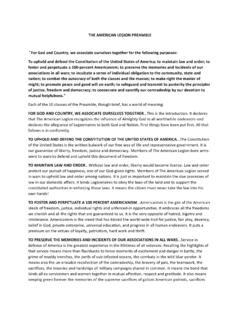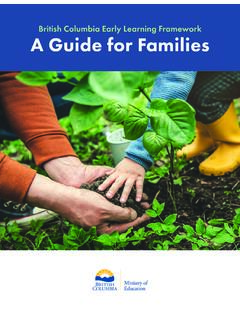Transcription of Statutory guidance on children who run away or go missing ...
1 Statutory guidance on children who run away or go missing from home or care January 2014 2 Contents Introduction 4 Status of this guidance 5 Who is this guidance for? 6 Definitions used in this guidance 6 Police definitions 6 Roles and responsibilities 8 Local authority 8 Local Safeguarding children Board (LSCB) 8 Multi agency working 8 Voluntary sector 9 Jobcentre Plus 9 Runaway and missing From Home and Care (RMFHC) protocol 10 When a child goes missing 12 Access to support 12 Risk assessment 12 When a child is found 14 Safe and well checks 14 Independent return interviews 14 Emergency accommodation 16 16 and 17 year olds 16 children who repeatedly run away and go missing 17 Collecting, sharing and analysing data on children who go missing 17 Additional actions to protect looked after children 19 Looked after children who are away from placement without authorisation 19 3 Reducing the risk of looked after children running away 19 Care planning and review 20 Out of area placements 20 children s home staff and foster carers 20 National Minimum Standards looked after children 21 Care Leavers 22 When a looked after child goes missing 22 When a looked after child is found 22 Data on looked after children who go missing or are away from placement without authorisation 23 Looked after children who may have been trafficked from abroad 24 Annex A 26 Checklist for local authorities 26 Annex B 27 Associated resources 27 4 Introduction 1.
2 Safeguarding and promoting the welfare of children is a key duty on local authorities and requires effective joint working between agencies and professionals. When a child goes missing or runs away they are at risk. Safeguarding children therefore includes protecting them from this risk. Local authorities are responsible for protecting children whether they go missing from their family home or from local authority care1. 2. There are no exact figures for the number of children who go missing or run away, but estimates suggest that the figure is in the region of 100,000 per year2. children may run away from a problem, such as abuse or neglect at home, or to somewhere they want to be. They may have been coerced to run away by someone else. Whatever the reason, it is thought that approximately 25 per cent of children and young people that go missing are at risk of serious harm3.
3 There are particular concerns about the links between children running away and the risks of sexual exploitation. missing children may also be vulnerable to other forms of exploitation, to violent crime, gang exploitation, or to drug and alcohol misuse. 3. Looked after children missing from their placements are particularly vulnerable. In 2012, two reports highlighted that many of these children were not being effectively safeguarded: the Joint All Party Parliamentary Group (APPG) Inquiry on children Who Go missing from Care and the accelerated report of the Office of the children s Commissioner s on-going inquiry into Child Sexual Exploitation in Gangs and Groups. Key issues identified suggested that: children in residential care are at particular risk of going missing and vulnerable to sexual and other exploitation; and Local Safeguarding children Boards have an important role to play in monitoring and interrogating data on children who go missing .
4 4. The Ofsted report missing children published in February 2013 on local authorities work in relation to children missing from home and care highlighted a number of concerns. These were that: risk management plans for individual looked after children were often not developed or acted on; 1 It is important that any looked after child should consider their placement as their home. This document uses the terms missing from care and away from placement to make clear the additional responsibilities of local authorities towards looked after children . When such a child goes missing , however, they should be considered as having gone missing from their home. 2 The children s Society: Still Running 3: Early findings from our third national survey of young runaways (2011) 3 ibid 5 placement instability was a key feature of looked after children who ran away; reports about looked after children missing from their care placement were not routinely provided to senior managers in local authorities; and there was little evidence that safe and well checks or return interviews were taking place.
5 5. Although looked after children are particularly vulnerable when they go missing , the majority of children who go missing are not looked after, and go missing from their family home. They can face the same risks as a child missing from local authority care. The same measures are often required to protect both groups of children . The first part of this guidance therefore refers to protecting all children from the risks associated with going missing , whether from home or from care. A separate section sets out the additional steps to be taken in regard to children missing from care. 6. This guidance sets out the steps local authorities and their partners should take to prevent children from going missing and to protect them when they do go missing . It is not intended to provide a comprehensive review of best practice, research or evidence regarding missing children .
6 This guidance replaces the Statutory guidance issued in 2009, in line with changes in evidence, policy and the Statutory framework covering looked after children . Status of this guidance 7. This guidance is issued under Section 7 of the Local Authority Social Services Act 1970, which requires local authorities in exercising their social services functions to act under the general guidance of the Secretary of State. Local authorities must comply with this guidance when exercising these functions, unless local circumstances indicate exceptional reasons that justify a variation. 8. It also complements: Working Together to Safeguard children and related Statutory guidance (2013); the missing children and Adults Strategy (2011); Safeguarding children and Young People from Sexual Exploitation (2009); the Tackling Child Sexual Exploitation Action Plan (2011); and the children Act 1989 guidance and regulations volumes on care planning and review.
7 6 Who is this guidance for? 9. The guidance is addressed to Chief Executives, Directors of children s Services and Lead Members for children s Services. It will be of interest to Local Safeguarding children Boards (LSCB) Chairs, senior managers within organisations providing services for children and families (including police, health, schools and the voluntary sector), as well as social care professionals, health and education practitioners and those who care for looked after children . Police forces should read this document in conjunction with Authorised Professional Practice guidance on missing Persons. Definitions used in this guidance 10. The terms below are used throughout this document with the following definitions: Child: anyone who has not yet reached their 18th birthday. children therefore means children and young people throughout this guidance .
8 Young runaway: a child who has run away from their home or care placement, or feels they have been forced or lured to leave. missing child: a child reported as missing to the police by their family or carers. Looked after child: a child who is looked after by a local authority by reason of a care order, or being accommodated under section 20 of the children Act 1989. Responsible local authority: the local authority that is responsible for a looked after child s care and care planning. Host local authority: the local authority in which a looked after child is placed when placed out of the responsible local authority s area. Care leaver: an eligible, relevant or former relevant child as defined by the children Act 1989. missing from care: a looked after child who is not at their placement or the place they are expected to be (eg, school) and their whereabouts is not known.
9 Away from placement without authorisation: a looked after child whose whereabouts is known but who is not at their placement or place they are expected to be and the carer has concerns or the incident has been notified to the local authority or the police. Police definitions 11. Since April 2013 police forces have been rolling out new definitions of missing and absent in relation to children and adults reported as missing to the police. These are: 7 missing : anyone whose whereabouts cannot be established and where the circumstances are out of character, or the context suggests the person may be subject of crime or at risk of harm to themselves or another; and absent: a person not at a place where they are expected or required to be. 12. The police classification of a person as missing or absent will be based on on-going risk assessment.
10 Note that absent within this definition would not include those defined as away from placement without authorisation above: a child whose whereabouts are known would not be treated as either missing or absent under the police definitions. guidance on how police forces will apply these definitions to children was issued by ACPO in April 2013. Paragraph 19 below explains how local protocols for safeguarding young runaways or children missing from home or care should reflect these definitions. 8 Roles and responsibilities Local authority 13. Section 13 of the children Act 2004 requires local authorities and other named Statutory partners4 to make arrangements to ensure that their functions are discharged with a view to safeguarding and promoting the welfare of children . This includes planning to prevent children from going missing and to protect them when they do.

















